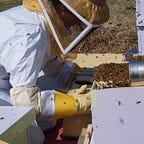The Difference Between Bee and Human Cyclical Behavior
Bee colony behavior seems to roll with the seasons; the same behavior happens year after year, and the cycle begins again. Bee behavior during the year is like how humans have particular activities each season. If one thinks about it, tending our gardens and preparing for winter is like bees preparing for winter survival. Bees and humans use springtime to open things up and start fresh (hence, spring cleaning), and bee colonies behave similarly. However, although bees and humans have cyclical behaviors in life and throughout the year, there are some key differences worth noting for bee inquirers.
Bees’ Specific Roles Mean if They Live or Die
Yes, some bees are disposable, and their survival each winter is not expected. There are sacrificial bees that leave the hive when necessary to ensure enough food is available for the queen and baby bees. During warmer months, bees work tirelessly, and hives serve as storage facilities as bees prepare for colder months. The condition of a hive at the beginning of September can determine its ability to thrive in spring. If there is ample food when the weather turns cold, there is typically enough food to start feeding the queen in January, which means lots of bee babies in spring. If a hive has yet to collect and store enough food, the queen must wait until spring for her bee workers to gather food to start her brooding. The condition of the hive at the beginning of fall significantly impacts its health in the spring and its likelihood of surviving.
In most climates, the winter months mean a significant reduction of food sources coming into the hive, and this means that the older bees may perish. The substances from within the hive are used to close gaps and holes, so that very little cold air gets into the hive.
Hive Temperatures Are Critical to Survival
Hives are extremely temperature sensitive, and bees are experts at regulating temperature by their proximity to each other. Bees may behave differently in warmer climates since their ability to continue foraging throughout winter remains enough to keep the hive going.
Fun Fact: In some Asian honeybee species, the bees can cluster together and heat up to temperatures to kill a threatening hornet near their hive!
Bees Can Regulate Temperature Within the Hive
In freezing climates, bees will get in clusters in the hive and regulate temperature by getting close together and then moving further apart. Any breaks in the cold that offer moments of warmer temperatures outside allow bees to move to another area within the hive to continue feeding. If warmer temperatures do not come in the winter season, an entire hive may perish as it is unable to move safely to another location within the hive and survive.
Additionally, the queen will not lay eggs in winter because it is the most challenging time for bees to survive in extremely cold climates. In warmer temperatures, the queen may never stop laying eggs, and this allows for more consistent growth for a colony.
Swarming Should Be Expected in Spring
Many things happen in bee colonies in the spring. It is like cleaning the house because the weather encourages more activity, and more activity results in higher temperatures within the hive. In an effort to alleviate the heat, bees will spend time at the entry of the hive, and often experienced beekeepers will add space to hives that need more.
Witnessing bees swarming is incredible, but it may be alarming if you are unsure what they are up to. Knowing swarming is a normal part of the bee behavior cycle can bring comfort. However, when bees swarm, they find a new location to build, so bees and the queen leave the hive to a temporary location, usually a tree branch somewhere, and then when they get the message of the new site, they head to their new home. Other bees always protect the queen as scout bees find an ideal spot to call home. Bees immediately begin to build combs for storage and brooding. It is likely to see swarming in the warmest months of the year.
Harvesting Honey at The Peak of Summer
When hives are at capacity, typically in the summer, storage of food and pollen is essential. This time of year is also when honey harvesting is recommended because there is plenty of food for the bees, and experienced and knowledgeable beekeepers can harvest some of the ooey gooey goodness for themselves.
If you are thinking about becoming a hive parent (aka beekeeper), talk to a local beekeeper and find out some of their experiences. The beekeeping community is an incredible source of many things, including local honey, beekeeping tips, and safe bee removal and relocation when necessary.
